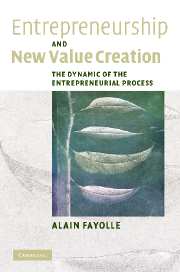Book contents
- Frontmatter
- Contents
- List of figures
- List of tables
- Foreword
- Acknowledgements
- Introduction
- Part I Perceptions of entrepreneurship
- Part II Entrepreneurship and the entrepreneurial system
- 4 A new perspective to understand entrepreneurship
- 5 Individual dimension in the I↔NVC dialogic
- 6 New value creation dimension in the I↔NVC dialogic
- Part III Entrepreneurship and entrepreneurial processes
- Part IV Entrepreneurial process dynamics
- Conclusion
- References
- Index
4 - A new perspective to understand entrepreneurship
Published online by Cambridge University Press: 22 September 2009
- Frontmatter
- Contents
- List of figures
- List of tables
- Foreword
- Acknowledgements
- Introduction
- Part I Perceptions of entrepreneurship
- Part II Entrepreneurship and the entrepreneurial system
- 4 A new perspective to understand entrepreneurship
- 5 Individual dimension in the I↔NVC dialogic
- 6 New value creation dimension in the I↔NVC dialogic
- Part III Entrepreneurship and entrepreneurial processes
- Part IV Entrepreneurial process dynamics
- Conclusion
- References
- Index
Summary
The perspective presented here largely draws on the works of Bruyat (1993). As already mentioned in the section on new value creation, for this author, ‘the scientific object studied in the field of entrepreneurship is the individual/value creation dialogic’ (Bruyat 1993: 57). As presented in chapter 2, the dialogic principle proposed by Morin (1989) implies that two or several perspectives are bound into a unity, in a complex manner (complementary, concurrent and opposing) without the duality being lost in the unity. This brings us back to the original postulate and ideology of our field where legitimacy depends on the acceptance or rejection of the idea that the individual is a necessary condition to the creation of value. Far from being a truism or a sophism, I will show that this perspective brings about theoretical and practical consequences. In the first section I develop the individual/new value creation dialogic, and I then discuss the related notion of change, which will bring us to another essential element, that of time. We will conclude this chapter by developing one significant consequence of our definition: the systemic vision of the dialogic pair.
The individual ↔ new value creation (I↔NVC) dialogic
A brief review of Gartner's research, which was presented in the introduction of this second part, shows that among the experts questioned, the author highlighted two groups: one focused on the characteristics of entrepreneurship, while the second put forward the outcome, with new venture creation as a common theme.
- Type
- Chapter
- Information
- Entrepreneurship and New Value CreationThe Dynamic of the Entrepreneurial Process, pp. 70 - 83Publisher: Cambridge University PressPrint publication year: 2007

